Inspired by an engaging time-filler meme on social media1 , my thoughts returned to that venerable roleplaying game Traveller, profiled on Tor.com earlier this year. Anyone who has played Traveller (or even just played with online character generation sites like this one) might have noticed that a surprising number of the characters one can generate are skilled with blades. This may see as an odd choice for a game like Traveller that is set in the 57th century CE, or indeed for any game in which swords and starships co-exist. Why do game authors make these choices?
There are three contributing factors in the Traveller game setting, two Watsonian and one Doylist:
- The Imperium doesn’t try to bring every world of the Imperium to the same tech level. There are worlds where fusion guns (human-portable) are standard military gear; there are planets where folks still use swords.
- A fair bit of in-game violence takes place on starships. You don’t want to use weapons that will trash the starship. Sure, Traveller bulkheads may be as robust as tank armour, but other equipment wouldn’t stand up to bullets.
- Swords and other edged weapons are cool.2 That’s the only reason that matters.
Just as games mix swords and starships, so do SFF novels. The trope goes way back, to the planetary romance novels of the Golden Age. Here are five examples.
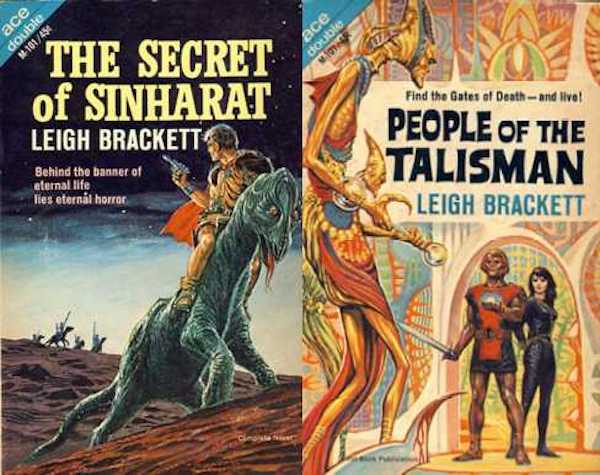
Let’s start with a planetary romance series. Leigh Brackett’s Eric John Stark, protagonist of such tales as The Secret of Sinharat and People of the Talisman (stories originally published 1949–1964), was raised by Mercurian natives after his human parents died in a cave-in. He survived the harsh Mercurian lifestyle as well as the massacre of the Mercurians at the hands of humans. He’s rescued from the killers by Simon Ashton of the Earth Police. The adult Stark has gained a patina of civility and can function in human-dominated society, but he has never lost his sympathy for oppressed peoples—nor his tendency toward ultra-violence.
In Brackett’s version of the Solar System, civilizations have arisen (and fallen and re-risen) on several planets.3 Some of these are/were technologically sophisticated, some aren’t/weren’t. In most of them, hi- or low-tech, the strong prey on the weak. Stark can handle weapons from sidearms to blades. He uses whatever works when he finds himself caught up in other people’s problems (as happens often enough to provide many thrilling adventures).
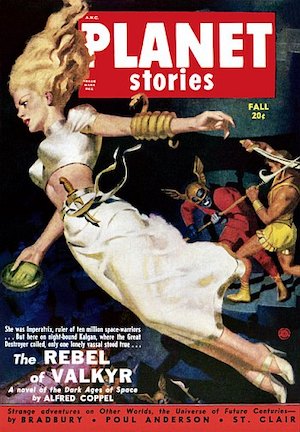
Golden Age SF also extended the planetary romance tropes to interstellar swords and starships. Alfred Coppel’s 1950 novella The Rebel of Valkyr (and the Rhada series of which the story is a part) features a grand interstellar empire. As so often happens with galactic empires, the first empire collapsed, and a very lengthy dark age followed. The new empire is only a shadow of the first.
The engineers of the old empire built well, so automated starships still ply the interstellar deeps, crewed by plate-armour-clad barbarians who haven’t the slightest idea just how far or fast they are travelling. Keiron, Warlord of Valkyr, is a feudal warrior, a believer in hierarchy (as long as he’s at the top) and conflict resolution by violent means (at which he is skilled). It’s bothersome to be opposed by people who resort to cunning and political machinations, as well as foes who refuse to die when stabbed.
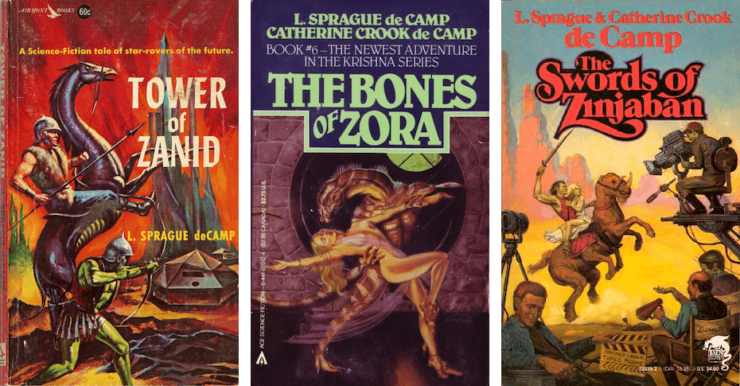
In L. Sprague de Camp’s Viagens Interplanetarias tales—The Bones of Zora (1983) (with Catherine Crook de Camp), The Tower of Zanid (1958), The Swords of Zinjaban (1991) and many others—relativistic starflight has revealed that our region of the Milky Way hosts many intelligent beings. Some worlds (like Earth or Osiris) are technologically sophisticated enough to build starships; others (like Krishna, Ormazd, and Vishnu) aren’t. The Interplanetary Council has imposed a technological embargo: no importation of technology that locals do not already possess. This decision is driven less by concern for low-tech cultures than by fear for their own well-being (imagine an alien Genghis Khan with starships and hydrogen bombs).4
In the long run, the embargo is clearly doomed; simply knowing that advanced technology exists is enough to inspire insightful rulers to seek out the means to develop it for themselves. In the short run, the policy facilitates no end of thrilling swashbuckling as Terran tourists fan out across worlds like Krishna armed with misplaced confidence, a keen interest in amorous encounters with the humanoid locals, and a profound ignorance of local customs.
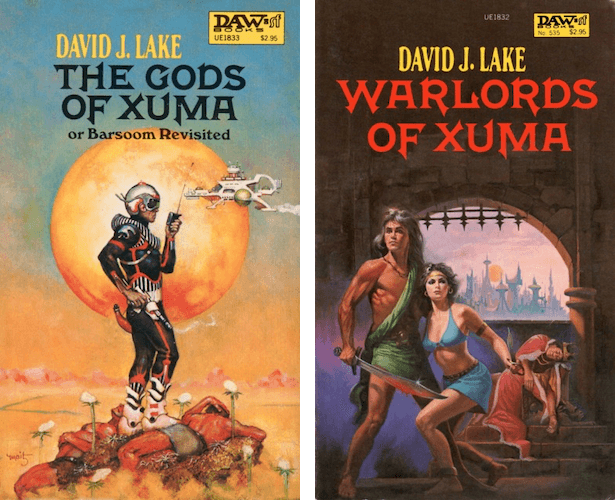
David Lake’s Disco-era sword and starship Xuma duology—Gods of Xuma (1978), Warlords of Xuma (1983)—combines de Camp’s playfulness with a considerably more jaundiced view of humanity. He sets a Barsoomian world against war-mongering, xenophobic human invaders. The duology is part of a larger series in which, alas, human flaws are given considerably more stage time than their virtues.
In the Xuma novels, humanity has only marginally survived two nuclear wars; it has been reduced to several (mutually hostile) lunar colonies. Nevertheless, it has managed to send slower-than-light starships out to explore the nearer stars. The Euro-American Riverhorse discovers that 82 Eridani 3—Xuma to its inhabitants—is the Mars our own Solar System never had: arid but life-bearing, a new home for humanity.
Pity that there are natives. However, they shouldn’t be a problem. The city-states of Xuma appear to have spent the last two million years satisfied to putter along with 18th-century technology. The same Euro-American military know-how that helped turned Earth into a glowing ruin should have no trouble at all dividing and conquering these hapless aliens. At least, that’s the story the humans tell themselves as they prepare what they expect will be a trivially easy invasion. Victory is assured! Although perhaps not for the Terrans…
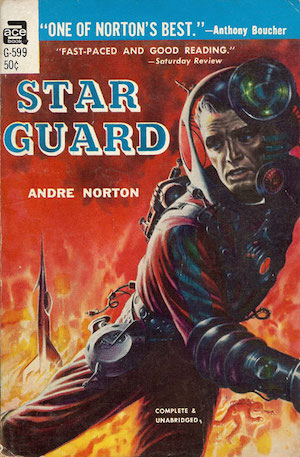
Perhaps the greatest (or at least a highly influential) example of a barbarians-in-space novel is Andre Norton’s Star Guard (1955). Here, the barbarians are human. The known galaxy is dominated by super-advanced aliens, who regard humans as naturally backward and violent. Humans are confined to Earth. A lucky few can venture out to the stars if they are willing to serve Central Control as “combatants” (AKA mercenaries).
Kana Karr is a Horde Combatant. Hordes are allowed to use only low-tech weapons. He and the Horde to which he is assigned are sent to the planet Fronn, there to ensure that the Central Control-favored side wins the on-going civil war. In short order, Karr discovers that:
- The Combatant unit to which he has been assigned has a curious assortment of skills for a Horde Unit.
- Someone has armed the opposing army with high-tech weapons.
The Horde must retreat; the retreat proves difficult. There is skullduggery in high places.
* * *
Swords and starships are an ongoing trope. Consider the success of the Star Wars franchise; consider the recent Gideon the Ninth. Or even better, the upcoming Harrow the Ninth, which is sitting on my coffee table.
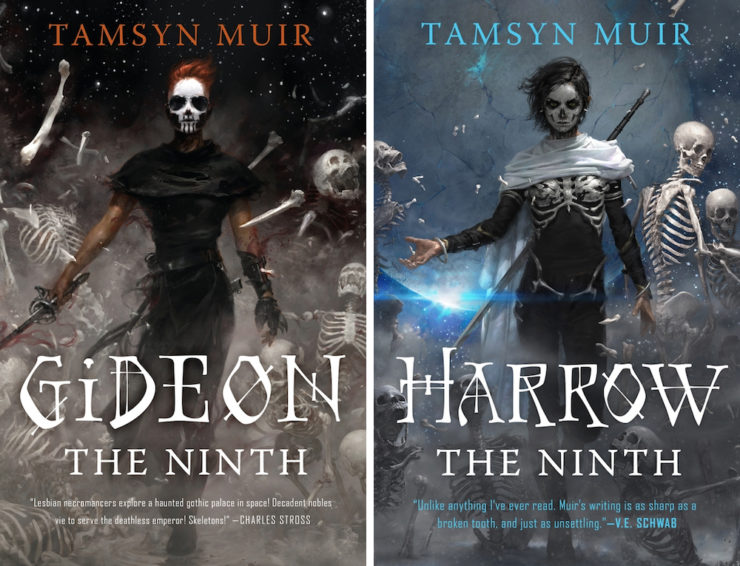
Buy the Book


Harrow the Ninth
I could go on (but I am sure that you will complete the list in comments).
In the words of Wikipedia editor TexasAndroid, prolific book reviewer and perennial Darwin Award nominee James Davis Nicoll is of “questionable notability.” His work has appeared in Publishers Weekly and Romantic Times as well as on his own websites, James Nicoll Reviews and Young People Read Old SFF (where he is assisted by editor Karen Lofstrom and web person Adrienne L. Travis). He is currently a finalist for the 2020 Best Fan Writer Hugo Award and is surprisingly flammable.
[1]I’m posting the covers of the first ten roleplaying games I encountered, in order, one per day. “Traveller” was the third. You might expect that the first would be the Win95 of roleplaying, AD&D. It was not. It was an ultra-obscure roleplaying game by John M. Ford named…ah, but I’ve run out of space in this footnote.
[2]Edged weapons are cool but they may not be good replacements for kitchen knives. Daggers, sure. But using a sabre to slice a banana can be kind of difficult. Learn from my mistake; make sure all of your fingers and thumbs are out of the way before slicing.
[3]Later, when space probes made her Solar System untenable, Brackett moved the action out the Solar System to Skaith, a doomed world that is totally not Old Mars with the serial numbers filed off.
[4]Which puts the Interplanetary Council one up on the Polesotechnic League, which trained and armed many alien mercenaries in the decades leading up to the sack of Earth by the descendants of said mercenaries.











In “Space Viking” the only swords are either planetary names, or ceremonial weapons. There are definitely barbarians though.
Can I give a shoutout to my personal favourite, CJ Cherryh’s Faded Sun trilogy? The Mri are a sword-using warrior species and function effectively within technologically advanced societies.
At one point during the Forever War, a suppression field (or something) makes swords useful for battle against Taurans.
Julian May’s Pliocene Exile has a spaceship or two lying around, lasers and swords (and mental powers galore).
@3
Huh. I completely forgot about Dune’s shields which made knives and swords the weapons of choice.
I believe Captain Harlock not only carried a sword, he sometimes stabbed people with his starship.
Glancing at my bookshelf, I note that Dune had an interesting excuse for bladed weapons (a generated shield that limited the speed of projectiles and interacted poorly – i.e. mutually assured destruction – with lasers). Wolfe’s Book of the New Sun has a prominent executioner’s sword. Hiro Protagonist of Stephenson’s Snow Crash is the world’s greatest swordsman (well, in VR anyway). And of course Heinlein’s Glory Road features sword fighting prominently, with a truly weak handwave of an in-story reason.
You added Gideon the Ninth just so you could taunt us with Harrow, didn’t you?
@@.-@: I forgot that too.
6: Yes No
The romantic notion that a high tech future will see the revival of swords and other primitive weapons is surprisingly common. It seems improbable. But I hope not.
Howard Chaykin’s Iron Wolf https://images.app.goo.gl/J87aYbthukuXUX8X9
And Cody Starbuck: https://images.app.goo.gl/RVC9UDkeWAM5C7N97
The Merrimack by R. M. Meleuch has swords on starships, with a fairly skillful handwave as to why they are necessary/useful. Merrimack Series
Not to mention a well known franchise, which very nearly came to an abrupt finish partway through the first movie.
Dang, I’m the first one to say, “Swords in spaaaaaace!” Thank you, MUPPET SHOW for that eternal line.
Bah. Swords. Lensmen had axes.
James Davis Nicoll@12: I had never noticed that particular moment, and it’s one of the funniest things I’ve ever seen. I wonder if they did it on purpose.
I don’t remember that moment either. Probably because I was looking at Alec Guineas, as who wouldn’t?
There’s a few more near examples from the Union/Alliance setting: Morgaine spends most of her time among sword age folk, and herself wields a sword that is not a sword; she travels between planets but does not use spacecraft to do so. And Merovin is an insufficiently abandoned Union colony where the outboard motor is the highest technology most people will countenance; one social stratum (see what I did there?) of the city of Merovingen boasts an (un)healthy sword dueling culture.
Gotta love a space pirate. Started with E. E. Smith’s vanBuskirk and his giant space-ax.
Do Warhammer’s chainswords count?
lest we forget:
@19: You’re goddamned right they do. Have you seen the trailer for the new edition yet?
https://www.youtube.com/watch?v=B9V0bOB8sXQ
I’m a little surprised no one has mentioned The Warlock in Spite of Himself, which is the first in a series called Warlock of Gramarye by Christopher Stasheff. it’s not quite like the examples given in that it’s about an interstellar spy who comes to a world where magic works, but definitely mixing swords with science fiction. He’s got a robot horse that’s quite remarkable. It’s an oldie, as am I, but definitely fun and worth a look!
Poul Anderson’s The High Crusade has a perfectly reasonable explanation for swords on starships. It’s the technology of our medieval protagonists.
Extending a bit beyond mere swords, Japan’s long-running Gundam franchise has occasionally bent over backwards to justify the use of giant humanoid combat-mecha for hand-to-hand fighting.
A notable recent (2015-2017) entry is Iron-Blooded Orphans, which relies upon the serial inventions of Ahab reactors (which produce immense energy but also flood the area with EM radiation, making other non-Ahab equipment unreliable [including things like radar and guided warheads]) and beam-scattering shielding (which makes directed-energy weapons not just useless, but dangerous due to wild ricochets). As a result, wars can either be fought at extreme long range (with unguided missiles) or extreme close range, with nothing in between (a mech-sized gun may still be better, but mech-sized swords/clubs/axes/maces/hammers/claws don’t run out of bullets).
I have an obscure one. Kennedy Hudner’s pretty darn entertaining three book MilSci series Alarm of War includes a teleportation device used to send soldiers from ship to ship to attack crews of other warships. It has the flaw of not being able to transport anything made of metal – so the soldiers being transported use plastic swords (and plastic pellet guns).
Pournelle’s A Spaceship for the King comes to mind. In Piper’s Paratime stories, high tech is not allowed in certain timelines. In L. Neil Smith’s Henry Martyn, personal shields make a kind of force sword the weapon of choice. Barsoom also comes to mind, as does Mongo. Come to think of it, I could do this all day…
The Paradox Men by Charles Harness:swords in a high tech culture with a shield to excuse them, and as many big concepts as you like.
@22: I came here to mention Stasheff only to find you’d anticipated my comment :)
I read an otherwise forgettable Star Wars ripoff which featured something called ‘bloodswords’ (or was it bloodsabres?) which functioned by having needles in the hilt puncture the user’s hand and power the blade through some kind of handwavy magiphysics or something. If you had the wrong kind of blood it wouldn’t work. or perhaps it would blow up your hand. I forget now. That’s how memorable the book was.
Do I dare mention “The Number of the Beast…”? Pournelle’s Janissaries or Weber’s Excalibur Alternative?
Or worse, Weber’s Safehold? Though, I will freely admit, there’s not a lot of starship in Safehold apart from the back story.
Amazingly enough, I’ve just discovered Ellis Morning’s Swords and Starships series books when I googled “Swords and Starships (funny how that works).
I always thought the “force field + laser = huge explosion” was an opportunity, not a barrier: use the laser as something like claymore mine. Its user can trigger it with a long string or it can be trigger by a trip wire. Or put it on an orbital platform, just shining along a path until it runs across that big shield over the palace.
—
@25,
Tough for people who have fillings, crowns, dental implants, or those plates and screws from various severe fractures.
@21, Do not mess with Space Nuns! And For the Emperor’s sake, Space Marines, wear your fraking helmets!
For an oldie but goody: Earthblood by Rosel George Brown and Keith Laumer has Space Pirate boarding parties armed with swords.
For newer books: A Pale Light In The Black by K. B. Wagers has Coast Guard boarding parties armed with swords.
(I just realized that both books have boarding actions in Near Earth Orbit)
@patrick Morris Miller, I do see what you did there!
No starships, but S M Stirling’s Island in the Sea of Time had a simple explanation for why the time travellers with access to guns carried swords as well. The Bronze Age people they were meeting didn’t know what guns were, but they knew what swords were. So swords were better at deterring violence.
@29 – lol. Metal would drop to floor after those transported got going, so one hopesthe metal wasn’t supporting anything important….
@33 – All those fillings and bone screws littering the floor!
It must be hard on people to have the iron in their blood left behind.
@30: Yeah, nice to see the Sororitas get some love. Though I do wish another Chapter besides the Smurfs would be featured for once. One day, Raven Guard, one day…
I’ll never miss an opportunity to plug my favourite game series and classics of the genre, Phantasy Star, which is the very epitome of swords & sorcery & starships. Mostly interplanetary shuttles but one game in fact takes place on — spoilers for a thirty year old Megadrive game ahead — an interstellar slowboat generation ship.
“Julian May’s Pliocene Exile has a spaceship or two lying around, lasers and swords (and mental powers galore).”
And IIRC, a laser sword! (Glass sword that emitted lasers.)
“It must be hard on people to have the iron in their blood left behind.”
If I had to No-Prize it I would say it excludes metals, as in conductors due to an electron sea, rather than specific elements.
Well now… interesting list. But to leave out one of the grand daddies of em all… for shame… A Princess of Mars (1912) Edgar Rice Burroughs. About the only thing the Disney movie got right was the complete mix of swords and technology.
And another one that probably shouldn’t be over looked, Orphans of the Sky (1941) Robert A Heinlein.
@12/15/16, I just rewatched the film and tragically, I don’t think that moment actually occurs in the movie — I’m guessing this is a still from an unused take or something?
I remember reading quite a few SF books involving swords especially in the 90’s.
Steve Perry wrote the Matador series which involved men (and women) highly specialized in combat, some of which involved swords (it’s been a while, but I remember a lot of stabbing).
Rutledge Etheridge wrote three books involving a highly trained guild of dualists in which swords featured prominently (Legend of the Dualists, The First Dualist, and Brother John).
Cary Orborne’s Iroshi trilogy (Iroshi, The Glaive, and Persea) were centered around a woman warrior who wielded a sword and rode around in space ships.
The protagonist in Blade Dancer by S.L. Viehl was good with her knives.
The Jaran series by Kate Elliott stars a space faring woman who is stuck on a planet with warriors reminiscent of the mongol tribesmen.
Empire of Silence by Christopher Ruocchio.
Hadrian spends a decent amount of time swording things in this love child of Dune & Name of the Wind.
There’s David Drake’s Ranks of Bronze and the sequel The Excalibur Alternative by David Weber. Low tech mercenaries brought into to negotiate at authorized tech level. Keeping human warriors as tamed killers wasn’t a viable long term strategy.
I always thought the “force field + laser = huge explosion” was an opportunity, not a barrier: use the laser as something like claymore mine.
I think this actually happens at one point. Doesn’t Paul suggest leaving a few shields lying around turned on when they withdraw from a position, to discourage the use of lasguns? The alternative would be, when attacking a position that contains shield-users, to strap a few lasguns to a drone and send it to fly overhead and spray fire at random.
*Ahem*
Possibly out of genre but Iain Banks The Bridge has one strand of barbarian /spaceship/Greek myth mixed in with proto steampunk and contemporary (90s) bits. Scottish dialect written phonetically and not easy to follow
@40 – Princess of Mars is a sword wielding classic, but no starships that I recall. Hence, not mentioned.
@39 – since it was designed, in story, as an offensive weapon by the bad guy empire to attack the Engineering/Navigation centers of opponent ships during space battles, they found a way around the iron in the blood issue, by implied handwavium or otherwise.
My Traveller scouts always had blade skills for low tech worlds and also for on board ships – do you really want bullets or energy weapons blowing up controls or equipment in deep space?
Besides what could be cooler than a Hawaiian shirt over a skin suit, saber in one hand and a pistol in the other? LOL!
Jack Vance’s Star-traveling protagonists often used swords on backwater planets.
The ‘Demon Princes’ and ‘Planet of Adventure’ series come immediately to mind.
Does Bob Shaw’s “Ragged Astronauts” (And “Wooden Spaceships”) count?
James David Nicoll @12: “Do not look into laser sword with remaining brain.”
Whenever I see swords in space, I remember the scene in Raiders of the Lost Ark, where Indy sensibly pulls out a pistol and shoots the swordsman.
A definite Sci-Fi series with low tech weaponry, the so-called “Chronicles of Counter-Earth”. Written by a “gentleman” named John Norman. I’m thinking of his “Gor” series.
The Red Rising Saga by Pierce Brown blends swords and technology quite well. Although they’re called “Razors” in the series, and they cut through pretty much everything except other razors. Only the masters of society, the Golds are allowed to have or use them. Definitely a great series, it moves quickly
@36, I though: Are those Ultramarines? And answered myself: Of course they’re Ultramarines! Nobody seems to know any other chapters exist! Personally I’m partial to Dark Angels.
@46, of course, Firefly!
Margaret Weis’s Star of the Guardians series. I believe that’s the one Jessica(28) was talking about. The royal family had nanobots in their blood, which allowed them to use some super sword.
The duels with light sabers at the climactic scene of Wolfling by Gordon R. Dickson!
@56: I’m just happy we’re finally getting some more melee-focused Primaris.
To be honest the mutual-explosion thing in Dune was another example of terrible worldbuilding. No, people are not going to walk around with (effectively) tiny nukes strapped to their belts that anyone within sight can set off at will. Even if by doing so they become bulletproof. Going from “someone within 600 yards can maybe shoot me with a bullet that maybe will kill me” to “anyone within line of sight can shoot me with a lasgun that will definitely kill me and everyone within a few hundred metres of me” is not an improvement to your personal safety.
@56,
I always thought “Ultramarine” was a funny name for some sort of sff super-soldier, because it just reminds me of a particularly vivid shade of blue. One expects the ultramarines to be wielding palette knives and riggers.
@60,
Yes! The first thing I thought of when I read Dune was laser land mines; the second was suicide bombers* with laser vests. There are all sorts of other questions: is there a minimum intensity? Does any laser frequency cause this? If it does, I can flood an area with low-intensity masers (which are just lasers using longer wave light) and set up a no-shield area. How does this effect connect the laser and the target? Even when Dune was written, pulsed lasers were common. A microsecond pulse produces a pulse of laser light about 300 m long. How does it connect the laser to a shield 5000 m away?
So many ways to use the laser+shield=BOOM! effect to military advantage. Laser land mines, airburst laser shells, using lasers to create no-shield zones. Mr Herbert did not think this one through. And don’t get me started on the prohibition on “machines that think.” Does this preclude a pocket calculator? How about a slide rule? A trip wire? An automatic door?
————-
* Suicide bombers weren’t invented by Islamic terrorists. It wasn’t unheard of for Japanese soldiers to wire themselves with explosives, raise their hands, and blow up themselves and the soldiers accepting their “surrender.” I’m sure that the suicide bomber idea was invented by terrorists of one flavor or another about the same time as explosives.
I was thinking that Turtledove’s The Road Less Travelled had swords and spaceships, but the Roxolani had flintlocks, not primitive swords.
I always thought “Ultramarine” was a funny name for some sort of sff super-soldier, because it just reminds me of a particularly vivid shade of blue.
The super-soldiers in question are, indeed, a particularly vivid shade of blue. (At least their armour is.)
Aged and creaky 40k players will remember that the original rules also included a chapter called the Rainbow Warriors, whose armour was much more colourful.
Thing is, the whole lasgun-shield thing isn’t just nonsensical, it’s unnecessary. Why not just say that shields block lasguns too? It’s handwave technology anyway. You still get your sword-and-dagger duels that way.
No one in Dune actually acts like they’re particularly worried about lasgun-shield interaction. There’s a scene where (if I remember) Stilgar tells Paul that they’re using lasguns to clear up some rubble, and Paul says tell them to be careful, there are shields active down there, and Stilgar says offhandedly yeah OK dad they’ll be careful or something like that.
That is not the response I would expect of someone who has just been told that his troops are mucking around with tiny nukes a few hundred metres away from his position.
I am puzzled why your Art Person chose to display at the top of this article a totally swell picture of the Magnetospheric Multiscale Mission spacecraft, which has nothing to do with either starships or swords. Unless— in the grand 1960s-1970s tradition of SF cover paintings that illustrate no scene whatsoever of the story within—it was chosen because it’s a totally swell picture.
I await your forthcoming entry, “Five Novels in Which Magnetospheric Physics Plays a Role,” in the hope that it will be illustrated by a picture of a hot babe brandishing a sword.
@65, Oh is that what that is?
61&63: most Space Marines go in for bright color schemes, in fact much of the fun of the Grimdark ‘verse comes from designing your very own colorful Space Marines.
Sisters of Battle tend to be more sober in their color choices, they are after all nuns!
61&63: most Space Marines go in for bright color schemes, in fact much of the fun of the Grimdark ‘verse comes from designing your very own colorful Space Marines.
The old Dan Dare comics explained their similarly bright-coloured spaceships, tanks etc by pointing out in a text box that future warfare was so dependent on ground-surveillance radar, thermal imaging and so on that there really wasn’t any point using drab paint to hide from view, because there were so many other things that would pick you up first. So they used bright colours because they looked nice and made it easy to tell which vehicles belonged to which unit.
@@@@@ Dune: Part of the reluctance to exploit the Shield/Lasgun interaction, I suspect, comes from the fact that, at a glance, the results look an awful lot like a nuclear explosion, and using nukes except in very specific circumstances is a good way to get the Emperor and the Landsraad lined up against you.
@67, Makes sense. What’s the point in being drab if the enemy can see you anyway?
I also thought that the shield/lasgun interaction blew both the shield and the gun that shot it? Which does, of course, raise its own set of questions.
@70- Unpredictably one, the other, or both, IIRC, with the exact energy of the resulting explosion also being unpredictable.
@63,
The super-soldiers in question are, indeed, a particularly vivid shade of blue. (At least their armour is.)
Aah… a pun.
You have no idea how easy it is get me to go on at length about variations in the Interstellar Medium like the Local Fluff. SF authors, alas, are more resistant.
@Several
lots of talk about H. Beam Piper, we should get a series (rereads even?) started on Tor. I love his books.
Stephen Hunt’s Six Against the Stars has a colony that’s regressed technologically to medieval times, though a character from there sticks around throughout, the environment drops after a few early chapters.
Dumarest saga has spaceships.knife fights lasers, swords and low tech mixed with hi tech
The Skies Discrowned by Tim Powers.
Surprised noone has yet mentioned The Deathstalker Saga by Simon R Green. In many ways is like a vanilla & straight version of Gideon, there’s even a bit of space necromancy involved.
@68,
Wouldn’t being in active rebellion against the emperor and the landsraat do that in any case?
I own Star Guard by Norton along with 55 other books in her collection. Leigh Bracket I’m a little light on and will now have to look for the one you have shown. I also have a number of L. Sprague de Camp’s books in my library.
My sci-fi collection runs almost 1000 books, going all the way back to Tom Swift Jr. and early Del Ray and Richard M. Elam Jr.
I was 10 yrs old when I started collecting books I would want to re-read in the future.. Now at almost 73 my collection is very multi genre.
@20 I only have two words to say about that image. Oh my!
Nobody’s mentioned David Weber’s “Flag in Exile”. While swords are more a ceremonial weapon on Grayson, they are used in duels.
Another good entry would be Kate Elliot’s Jaran series. I’m surprised no one has mentioned that one.
@74 I have reviewed H Beam Piper twice (Lord Kalvan of Otherwhen and Little Fuzzy) in my Front Lines and Frontiers column, and plan to revisit other work in the future. Stay tuned!
In Patricia Kennealy-Morrisons Keltiad, armies meet hand to hand with swords due to Intergalactic Convention. The idea being that it is easier to press a button to kill lots of people at at a distance than to run an individual through with a sword. The quote that went with this bit of backstory was a character musing, “Keep the gore in war, it might even help to keep the peace.’
I’m sure it was also to justify having swords in the books.
@80 Thank you! I was coming to mention that for HH fans.
@27, I was in fact going to mention Henlein’s “Number of the Beast” which not only includes swordplay but which specifically notes that while it may not be PRACTICAL to carry a sword as opposed to a gun in some cases, for some people it can be a visceral reassurance. And it also has a cool nod to his MUCH more sword focused (and earlier era) “Glory Road” which uses dimensional travel to places where either primitive cultures or different laws of physics make firearms or energy weapons impractical.
No one has mentioned A. E. van Vogt’s fixup novel Empire of the Atom. Read this in high school! Much of Planet Stories used this motif!
Like the Keltiaad, Darkover used swords (or long knives) by convention.
@42 Steve Perry’s Matadors and the Mushashi Flex…. Good gods I read those over and over.
@80. There might be swords, but they were kinda patched in, especially in the climactic scene. But if one is trying to portray HH as a true killer, that scene did an excellent job. The Steadholder could not make the mental adjustment that it was a death duel and not merely a competition duel… And that women can fight with weapons as well as men. Nevermind that she is genetically enhanced and has been studying martial arts for decades….
As both C.J. Cherryh’s Morgaine series and the last season of She-Ra showed, carrying a sword in a milieu with blasters and spaceships merely requires one to have a sufficiently powerful sword. There’s probably a few other stories featuring swords powerful enough to take on starfleets, most likely from the New Age SF era.
One of the best Swords and Spaceship series, I think, is the Rhada series by Robert Cham Gilman published in the late 1960’s. I wish this was on Kindle today as that is the easiest for me to read although I still have then in paperback.
Fairly early in the essay, I say
Gilman was a pen name for Alfred Coppel.
@78- Well, maybe. But unless you were explicitly stating your intention to kick over the entire table, more likely you’d have whoever you were directly rebelling against and maybe their closest allies/catspaws, with the rest of the Houses either covertly supporting you or just standing back to watch where the chips fall and try and turn it to their advantage.
Paul, of course, does kick over the entire table. And he uses the family atomics to help him do it, but by the time the dust settles from that, he’s already set the table back up and installed himself at the head of it, with his finger on the button to the trapdoors underneath everyone else’s chairs, and openly opposing him is really no longer an option.
One of the results of the Guild’s monopoly on space travel is that pretty much everyone with the resources to effect change on the scale of overthrowing the system stands to lose a great deal by doing so.
I’m ashamed that it’s taken me this long to bring up everyone’s favourite scrappy space-ninja loot-shooter Warframe.
https://www.youtube.com/watch?v=MsbL8lFHrZI
“Something for everyone, it’s Barrayar tonight!
Refuel the ships/call in the loans
Bring on the werewolves, quaddies and clones,,,”
(sound of a scuffle, whimpering cries of a filker being dragged offstage…)
@93: Bravo!
In William Walling’s No One Goes There Now, swords are used for the traditional purpose: settling matters of honor in the aristocratic tradition. They have more “modern” weapons and don’t hesitate to use them for protection or aggression, swordplay is about social standing.
@61:
The actual rule is something like “Thou shalt not make a machine in the image of a man’s mind.” Even when Herbert wrote the original Dune, there was a distinction between mechanisms and computers; there were plenty of mechanisms around, but the serious computing/planning/… was the realm of mentats. Nowadays the Internet of Things may be blurring the distinction — but that’s the sort of actual future that writers seem to have shot all around without actually hitting.
@91: just so — the cost of heavy-duty enforcement is non-trivial (a fact Herbert seems to have realized well before some of our leaders…).
@0: thank you for citing The People of the Talisman; I’m fond of pointing to it as one of the earliest female heroes (a different category from “heroine”), complete with an edge-uppermost feminist statement. (Blanked for a spoiler, for anyone who hasn’t read it.)
@96,
“Thou shalt not make a machine in the image of a man’s mind” begs the question: what does that statement mean? I can see a particularly fundamentalist Bulterian Jihadist include pocket calculators — there don’t seem to be any computing machines* in Dune — into the bin of an “image of a man’s mind.”
I find a lot of world building issues with Dune, with one of the worst problems being sandworms. How does a huge (100+ meters long) animal evolve on a desert planet? What does it eat? At absolutely best, the biology was wonky.
—
* Well, except for the Guild navigators, who are hardly human.
You have the Simon Green “DeathStalker” Series that uses swords while waiting five minutes inbetween laser weapon shots. These books have a lot of sword fighting.
Did anybody mention Flash Gordon? Aaha!
@97: a pocket calculator is a flashy abacus, not an imitation of a human mind. If you’d said “programmable calculator” (do those even exist any more?), you could fault Herbert for not seeing a decade-plus into his future — but that would damn just about every SF author. (Consider Starman Jones, in which course information has to be manually toggled into the navigation gear, which has so little memory that printed books of tables are jealously guarded.) Even Asimov, who may have been the first author to suggest a pocket calculator, described it as essentially a compact adding machine (in “A Feeling of Power”).
Your complaints about biology are a little dusty at this point; Hal Clement pointed them out when Herbert was GoH at Boskone in 1979, and IIRC he treated this as long-known. Herbert was one of the earliest writers to take ecology seriously, but he wasn’t a biophysicist.
Minor comment — the Leigh Brackett novels are revisions and expansions of her earlier (and somewhat different) Planet Stories novellas “Black Amazon of Mars” and “Queen of the Martian Catacombs”. In both cases, the magazine versions are different enough to make it worthwhile to read both versions. More interesting than that … there are good reasons to believe that the expansions, the Ace Double versions, were actually done by Brackett’s husband Edmond Hamilton.
Also — love all this stuff. And particularly the Coppel stories … (the Rhada books actually published as by Robert Cham Gilman.)
@96:
The pocket calculator in “The Psychohistorians” (the chapter of Foundation written in 1957, before “A Feeling of Power”) is surprisingly like a programmable calculator
“Seldon removed his calculator pad from the pouch at his belt. Men said he kept one beneath his pillow for use in moments of wakefulness. Its gray, glossy finish was slightly worn by use. Seldon’s nimble fingers, spotted now with age, played along the hard plastic that rimmed it. Red symbols glowed out from the gray“
What about Deathstalker?
@100,
RE: Biology
One of my gripes about quite a lot of hard sf is that the biology frequently rises to the level of bad, but is usually ridiculously bad. Their psychology, sociology, economics, and political science are barely better.
RE: Calculators
How would anybody define “a machine in the image of a man’s mind” in a way that’s reasonably unambiguous? I can see religious schisms that would make those of early Christianity or Islam look like petty squabbles erupting from interpretations of that phrase. Dune was published in 1965, so it was written before Terry Winograd wrote SHRDLU and the MIT Mac project wrote Macsyma*, but both were written before any of the sequels, and were known the (well, somewhat nerdly portions of ) the public before the Children of Dune (1975) and possibly Dune Messiah (1969). Macsyma, at least, was fairly well known before The God Emperor of Dune, Heretics of Dune, and Chapterhouse: Dune, and all of the books written by Brian Herbert and Kevin J Anderson.
——-
* Macsyma was the first computer algebra system. It could factor polynomials, integrate and differentiate formulas, and solve differential equations. Was it “a machine in the image of a man’s mind?” SHRDLU could manipulate blocks. Eliza can provide moments of fun and keep some people occupied for hours with its imitation of conversation. Were any of these “in the image of man’s mind?” How about the ballistics computers used in WW2-era battleships? The digital computers used by Ultra? Where would you put the boundary? According to https://dune.fandom.com/wiki/Butlerian_Jihad, it was set really low. I’m not sure which side an alarm clock would fall on.
@@@@@ Sandworms
I had somehow concluded (perhaps based on the general absence of other clearly alien species?) that Dune’s sandworms/sandtrout had been made, not evolved on their own, but now that I search, that doesn’t actually appear to have been based on anything stated in the books. And would, admittedly, still leave the question about what they eat (especially as the smaller Sandtrout only evidently turn into the giant worms in a sufficiently desert environment?)
@105
In one of the appendices for Dune it’s stated (I think, maybe just heavily implied) that sandworms were introduced to Arrakis. Presumably by forces unknown.
@5 (James Davis Nicholl)
Just to point out one thing that was missed in your reasoning for the swords-in-space of Classic Traveller:
The setting, complete with speed-of-communication that could only keep up with 3 to 18 parsec jumps that took a week plus refueling before the next one, and an Imperium that spanned 11,000 world and was likely about 1500 parsecs across… messages went slowly. That also meant central powers could not govern directly but had to send suitable proxies and authorize them to do what had to be done.
This model was drawn from 17th-19th century age of sail. Colonies were far away. You sent a noble, governor, or general to run the place and they had to fend for themselves for the large part but ensure some tribute was sent back to the mother country. Marc Miller (Traveller creator) had an interest in history and in this period and that’s part of why the setting is as it is.
And if you have ‘sailing ships’ in space (though not quite as explicitly as the Republic of Cinnabar stories of David Drake with their giant riggings and sails to navigate otherspace), then you want to have pirates, privateers, and swords.
@40 – John Carter (the movie) also cast well for Dejah Thoris. I’m not convinced the protagonist was as well cast and they certainly muddled about with the stories, but to be honest, if you made some of the Mars stories from that line today, they’d cause some controversy. And their flying ships were kind of neat. It could have been better, but it wasn’t Battlefield Earth awful.
@107-
The overriding thing that stuck with me from the John Carter movie was a scene where Tars Tarkas (played by Willem Dafoe) while talking about John’s leaping ability, demonstrates by miming a jump with his fingers from one hand to another. It told me that someone (or multiple people!) had thought down and given some thought to how an individual with more than two limbs would utilize them when communicating, and then gone ahead and added it to the film without feeling the need to stop the action to draw attention to it. I appreciate that sort of little worldbuilding touch- when I’m clever and attentive enough to pick up on it, which isn’t always!
@107,
One rather obvious problem problem is that Barsoomians eschew clothing. Disney would have trouble getting a PG-13 rating if they followed the story accurately